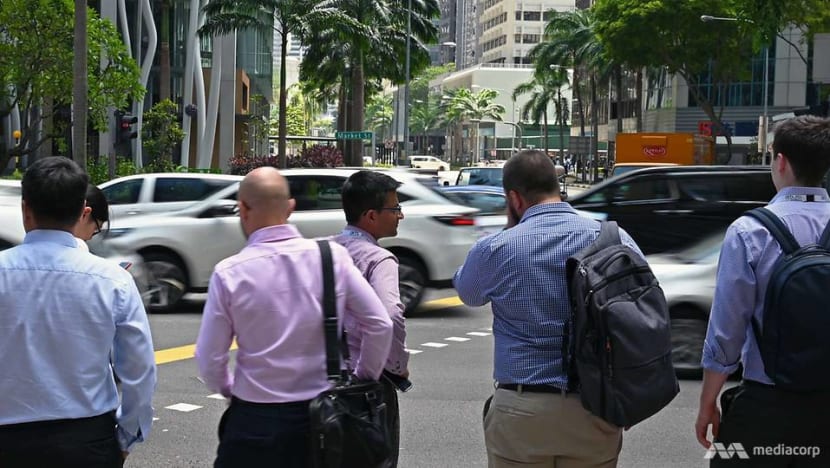Median monthly household income exceeds S$11,000 in 2024, a 1.4% rise after adjusting for inflation
The growth in median monthly income from work was slower in 2024 than the year before – Singapore saw the figure grow by 2.8 per cent in 2023.

Office workers at Raffles Place in Singapore. (File photo: Marcus Mark Ramos)

This audio is generated by an AI tool.
SINGAPORE: Median monthly household income from work in Singapore rose to S$11,297 in 2024 from S$10,869 in 2023, or by 1.4 per cent in real terms after adjusting for inflation.
The growth in median monthly income from work was slower in 2024 than the year before – Singapore saw the figure increase by 2.8 per cent in 2023.
Accounting for household size, the median monthly income per household member rose by 0.8 per cent in real terms, from S$3,500 in 2023 to S$3,615 in 2024, similarly seeing slower growth compared to the year before.
The numbers were released on Thursday (Feb 13) in the Key Household Income Trends 2024 paper by the Singapore Department of Statistics (Singstat).
In the last five years, median monthly household income from work increased by 0.7 per cent per year in real terms after adjusting for inflation, the paper found.
The figure per household member grew by 1.3 per cent per year in real terms over the same period.
The average household employment income per household member increased across all income deciles in 2024, by between 0.6 per cent and 3.2 per cent in real terms.
The figure for households in the lowest decile and the highest decile went up by the same amount – 3.2 per cent.
SingStat noted that some resident employed households in the lowest 10 per cent owned a car, hired a domestic helper, lived in private property or had a household reference person aged 65 and over.
The household reference person may refer to the oldest member, the main income earner, the owner-occupier of the house, the person who manages the affairs of the household, or the person who supplied the information pertaining to other members.
Similar to last year, the average household income from work per household member of resident employed households in the first nine deciles rose by 0.3 per cent to 1.9 per cent per annum in real terms between 2019 and 2024.
For households in the top decile, this dropped by 0.7 per cent per annum.
MORE GOVERNMENT TRANSFERS
In 2024, households received more government transfers in 2024, with those that live in one- and two-room Housing and Development Board (HDB) flats receiving the most.
Households received an average of S$7,825 per household member from government schemes in 2024, up from the S$6,418 in 2023, said Singstat.
“This was due to measures rolled out in 2024 to support households in areas such as cost-of-living, retirement and healthcare needs,” it said in the press release.
Households that live in one- and two-room HDB flats received an average of S$16,805 per member from government schemes, more than double the average received by all resident households.
The Gini coefficient, which measures income inequality, fell to a record low. A Gini coefficient of 1 indicates perfect inequality, and a lower figure indicates less income inequality.
The coefficient rose from 0.433 in 2023 to 0.435 in 2024, before government transfers and taxes.
After adjusting for government transfers and taxes, the Gini coefficient was 0.364, lower than the 0.371 in 2023, and the lowest since records began in 2000.
“This reflected the increase in government support for lower- and middle-income resident households,” Singstat said.
















